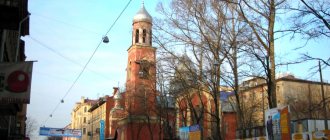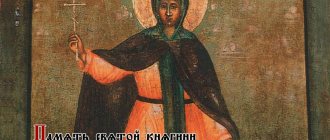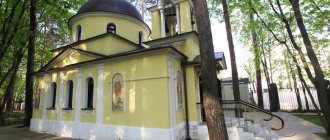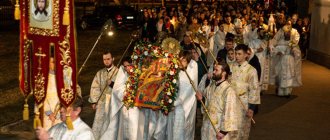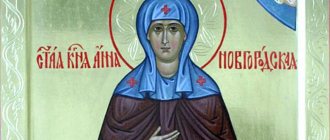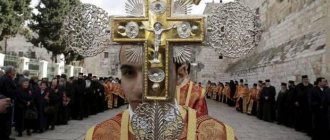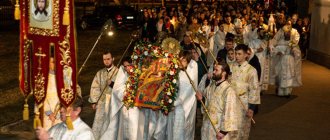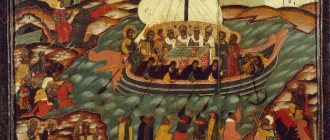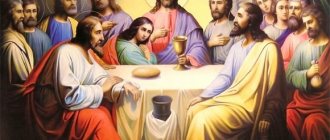- Processions of the Cross Pilgrim's ABC
- About holy icons and religious processions
- Discourse on religious processions of the Orthodox Church
- History of religious processions Priest Evgeniy Purtov
- Walking religious procession Dmitry Anokhin
***
Procession of the Cross is a reverent procession of believers with icons, crosses, banners and other Christian shrines, organized with the purpose of glorifying God, asking Him for mercy and gracious support. The religious procession can be carried out either along a closed route, for example, around a field, village, city, temple, or along a special one, where the starting and final destinations are different.
The religious procession is deeply symbolic. The solemn ringing of the bell expresses the triumph of the Cross of Christ, majestically worn, surrounded by a host of faithful who follow him like warriors following their sign. The religious procession is led by saints, whose icons are carried in front.
Processions of the cross consecrate all the elements of nature (earth, air, water, fire). This comes from icons, incense, overshadowing the altar cross in all directions, sprinkling with water, burning candles...
***
Not a flash mob or demonstration
What is important to know? Not any popular procession is called a procession of the cross (not to be confused with the Crusades), otherwise it could be confused with a demonstration or some kind of flash mob. Even external attributes, the presence of icons, crosses, banners cannot be a guarantee that he is exactly that.
Firstly, such a procession always has an absolutely specific goal, a reason (we will talk about them a little lower). Secondly, it must be performed only with the blessing of the archpastor, the bishop. Thirdly, such a procession must be led by a legally ordained priest or the same bishop.
But these, too, let’s say, are only organizational, formal signs of moves, which are by no means responsible for their success. The main thing that should be present at such a procession of believers is a common spirit of prayer, unity of faith, mutual love and respect. Without them, any such “action” threatens to turn into an ordinary walk, or even - which is much worse - into a magic trick. Let us emphasize that what is important here is not only a prayerful, but a community spirit, and one that is peaceful towards everyone, even enemies.
How does the Easter procession take place?
Festive services begin on Holy Saturday at 8 pm. You must wait until midnight to see the procession. The service is held in the church, in semi-darkness, by candlelight. Even those who do not consider themselves believers watch with interest the ceremony accompanying the great holiday of the Resurrection.
The main difference between Easter services is their solemnity. Temples are filled with a special atmosphere, you can feel the approach of the holiday, which for millions of Christians is the moment of truth.
Before Easter there is a religious procession. It is organized on the day of the Holy Resurrection of Christ, and since ancient times symbolizes the desire of Christianity to go to the Savior. In addition, believers who follow the priests put another meaning into it: the procession is the path to the Light, which Christ showed to people wandering in the dark.
Order of ceremony
The Easter procession does not last long, but it is decorated very solemnly. Every believer strives to take part in this festive event that glorifies Christ.
Why do people come with crosses and icons?
So, we can say that such church moves are a type of general prayer. Of course, then the question involuntarily arises: why go out into the street, make some kind of processions, if you can pray in church? The answer to it is the same as to the question: why are fasting and bowing necessary? We do this when we want to add some kind of sacrifice to our prayer so that it is heard.
Is the religious procession a manifestation of one’s faith? Perhaps from the outside this is exactly what it looks like. But this, of course, is not the main goal. Its goal is to invoke God's grace, first of all, on all people, believers and non-believers, on the place where they pass: the city, the country and, ultimately, the whole world.
In addition, through such prayer solemn processions, natural elements are sanctified: fire, water, air. Previously, people better understood that any natural disasters are not just abstract environmental problems, but the wrath of God for our sins. That’s why they made such popular processions to beg the Lord for mercy.
The crusaders carry crosses with them (which is why it is called a procession), icons, and banners. Banners are sacred church banners that should not be confused with state ones, since the power of Christ is “not of this world.” The very first to carry a lantern (as a sign of the Gospel light, enlightening the whole world).
The cross is the main banner of Christians, a symbol of victory over death, a testimony of faith. Therefore, a move without him is, of course, unthinkable. Through the icons the saints themselves, the heavenly host also invisibly takes part in it. Sometimes, on the day of remembrance of a saint or his glorification, on special occasions, processions are also carried out with the relics of the saints of God.
The start of religious processions around Russian cities has been announced
Olga, as is known, the Russian people suffered the collective sin of apostasy, which led to the fall of the Orthodox kingdom and many years of incessant turmoil. I think it wouldn’t hurt to post some quotes from enlightened people here: • According to the saint and wonderworker John of Shanghai and San Francisco (Maximovich), “the Russian people as a whole committed great sins that were the cause of real disasters, namely: perjury and regicide... All the people are guilty of shedding the blood of their King. Some killed, others approved of the murder and thus committed no less a sin, others did not interfere... It is a great sin to raise a hand against the Anointed of God. Not even the slightest involvement in such sin remains unavenged... All are guilty, and truly we must say: “His blood be on us and on our children” (Matthew 27:25). But let us remember that this atrocity of the entire people was committed on the day of St. Andrew of Crete, calling us to deep repentance” (the word spoken before the service about the repose of the souls of Sovereign Nicholas II and those killed with him in 1934). •St. Seraphim (Sobolev) said that the entire Russian people as a whole must take “the path of repentance for their sins, especially our most serious sin, of which all Russian people are actively or passively guilty - the sin of rebellion against the autocratic power of our Tsar - the Anointed One God's. This sin is so grave for us because it entails the loss of conscience by Russian people, their removal from the Church - its faith, teaching and grace. It is the height or fruit of those various religious and moral grave crimes that were committed by Russian people for many, many years" (Archbishop Seraphim (Sobolev). Russian Ideology. M.: "Lestvitsa", 2000, pp. 82-83). Many pious shepherds also spoke about the need for repentance for the sin of regicide. • Archbishop Averky (Taushev) wrote: “It is little consolation for us that the direct murder of the royal family was not committed by Russian hands - by the hands of non-Orthodox and non-Russian people. Although this is so, the entire Russian people are guilty of this terrible, unparalleled crime, since they did not resist or prevent it... This crime is completely unprecedented in the history of not only Russia, but of all humanity in its extreme tension of evil forces, in its incredible , one might say, even senseless cruelty... All Orthodox Russian people, after everything they have experienced since then, should finally see the light and give a proper assessment of everything that happened - the whole bloody disaster that befell our Motherland as a result of the terrible sin of regicide" (Archbishop Averky ( Taushev). Modernity in the light of the word of God. Words and speeches. Vol. III, Jordanville, 1975, p. 298). Bishop Nektary (Kontsevich), a disciple of the Venerable Elder Nektary of Optina, in a word spoken before the glorification of the holy Royal Martyrs and all new martyrs and confessors of Russia by the Russian Church Abroad in 1981, indicated: “The mortal sin of regicide weighs heavily on the entire Russian people, and therefore to one degree or another over each of us" (Yearbook "Orthodox Path"). •In the 90s of the 20th century, a nationwide sermon by Metropolitan John (Snychev) was heard from St. Petersburg throughout the country: “It is no coincidence that both of the greatest Russian troubles (the beginning of the 17th and the beginning of the 20th centuries) were associated with regicide... The history of Orthodox Rus' in its highest, spiritual manifestation serves as an organic continuation of the Sacred History of the New Testament. The figure of the Anointed of God, the Russian Orthodox Tsar, is from this point of view a visible symbol of recognition by Russian society of its providential destiny, a living seal of the Testament, the personification of the primacy in Russian life of the Commandments of God over human laws. Hence, by the way, the autocratic character of royal power - not earthly, but heavenly, according to the word of Scripture: “The heart of the king is in the hand of the Lord... Wherever He wants, He directs it” (Prov. 21:1). Actually, regicide in the spiritual understanding is a rebellion against God, a challenge to His Providence, an atheistic impulse of satanic, dark forces... Willingly or involuntarily, consciously or unconsciously, the entire people participates in regicide, if only by allowing it, not trying to atone for the terrible sin of rejection of God by repentance and correction. And only then, plunged into the abyss of disorder and rebellion, in suffering and sorrow, he finally realizes his mistake. At the beginning of the 17th century, this took eight years. In the twentieth century, the eighth decade of unrest is already coming to an end...” (Metropolitan John (Snychev). Jordanville, 1985, p. 45). •Learn, Russia, to believe in God Almighty, who rules the destinies of the world, and learn from your holy ancestors faith, wisdom and courage. The Lord has entrusted to us, Russians, the great, saving talent of the Orthodox faith... Rise up, Russian people!.. Who taught you disobedience and senseless rebellions, which never existed before in Rus'?.. Stop being crazy! Enough! It’s enough for you and Russia to drink the bitter cup full of poison!” “Remember that the earthly Fatherland with its Church is the threshold of the heavenly Fatherland, therefore love it fervently and be ready to lay down your soul for it... The Lord has entrusted to us, Russians, the great saving talent of the Orthodox faith... Arise, Russian man! Stop being crazy! Enough! It’s enough to drink the bitter cup full of poison—for both you and Russia.” (St. Righteous John of Kronstadt) •People will never change to please us, will never meet our expectations, even the best of people. Expectations always create hopelessness and suffering. And they lead to grumbling. Departure from God is murmuring against Him and is a grave sin. It fetters and kills the soul, usually under the guise of a search for higher justice. (Metropolitan Anthony (Pakanich).
Old Testament types
The very first prototype of such a procession of believers, perhaps, can be the forty-year campaign of the Israelites through the desert in search of the Promised Land. The most striking example of the effective power of such popular processions is the capture of Jericho. The Book of Joshua tells about this (Joshua 5:13-6:26).
In a special revelation, he was ordered to walk around this city for seven days with the Ark of the Covenant, while blowing the trumpets. The ark was carried by the priests, the soldiers walked behind. On the seventh day, the Israelites blew their trumpets and shouted loudly and with one voice, after which the wall of Jericho collapsed and the city surrendered.
Also, the Jews on the Feast of Tabernacles had a tradition of a seven-day solemn procession around the almemar (a place in the synagogue) with palm branches. Another vivid prototype can be the transfer of the Ark of the Covenant by King David to Jerusalem, in which the entire people of Israel participated “with shouts and the sound of trumpets.”
Easter service
Easter services are especially solemn. Christ has risen: eternal joy, sings the Church in the canon of Easter. Since ancient, apostolic times, Christians have been awake on the sacred and pre-festive saving night of the Bright Resurrection of Christ, the luminous night of the luminous day, awaiting the time of their spiritual liberation from the work of the enemy (Church Charter on the week of Easter).
Shortly before midnight, a Midnight Office is served in all churches, at which the priest and the deacon go to the Shroud and, having censed around it, while singing the words of the catavasia of the 9th song, “I will arise and be glorified,” they lift the Shroud and take it to the altar. The Shroud is placed on the Holy Altar, where it must remain until Easter.
Easter Matins, “the joy of the Resurrection of our Lord from the dead,” begins at 12 o’clock at night. As midnight approaches, all clergy in full vestments stand in order at the Throne. The clergy and worshipers light candles in the temple. On Easter, just before midnight, a solemn bell announces the onset of the great minute of the Luminous Feast of the Resurrection of Christ.
In the altar, quiet singing begins, gaining strength: “Thy Resurrection, O Christ the Savior, the angels sing in heaven, and grant us on earth to glorify You with a pure heart.” At this time, jubilant Easter peals ring out from the height of the bell tower. Then the procession begins
During the service, the priest again and again joyfully greets all those praying with the words “Christ is Risen!” and every time the worshipers answer: “Truly He is Risen!” At short intervals, the clergy change vestments and walk around the temple in red, yellow, blue, green and white vestments.
At the end of the service, the catechetical word of St. John Chrysostom. In the evening of Easter, an amazingly beautiful and joyful Easter Vespers is served.
https://youtu.be/akAFtctyxgw
Easter is celebrated for seven days, that is, the whole week, and therefore this week is called Bright Easter Week. Each day of the week is also called bright - Bright Monday, Bright Tuesday. The Royal Doors are open all week. There is no fasting on Holy Wednesday and Friday.
Throughout the entire period before the Ascension (40 days after Easter), Orthodox Christians greet each other with the greeting “Christ is Risen!” and the answer “Truly He is Risen!”
John Chrysostom and the establishment of tradition
During the Savior’s earthly life, an example of a procession of the cross could be His solemn entry into Jerusalem. Then all the people greeted Him with the words “Hosanna!” and laid palm branches under their feet. We know that already in the first centuries in the early Christian community there was a tradition on Easter day to symbolically, following the example of the myrrh-bearing women, walk around the temple with candles in hand.
This can be considered the beginning of a tradition, but the rank (order) itself did not yet exist. Then, it is known that the newly discovered relics of the saints were carried over in the same solemn manner by the entire community. These processions took place at night and were accompanied by general prayer in the form of singing hymns (psalms). They were called lithiums (not to be confused with their modern form) or lithiums. They served as the beginning of the modern religious procession.
The authorship of the first rite is traditionally attributed to St. John Chrysostom. At first they were created in opposition to the Arians - the saint did not want people to participate in their Sunday pleasure meetings. Then, during the time when Chrysostom lived (IV century), a series of natural disasters followed. So from a simple pious tradition they moved into general church practice, where they became entrenched.
Church regulations
During religious processions they carry church icons and crosses, and sometimes, where available, the relics of saints; On the roads and crossroads, prayer is performed in order to sanctify both people and everything that they need for life, i.e. houses, paths, waters, air and the earth itself, as trampled and desecrated by the feet of sinners (Simeon. Solun. ch. 353. New Tablet. art. 544-545).
Processions of the cross are supposed to take place on the days of Epiphany, Mid-Pentecost and the Origin of the Honest Trees (August 1) for the blessing of water (Typ. see January 6 and August 1).
In addition, religious processions can be carried out at the request of other special circumstances, such as, for example, in fields during rainlessness, around cities and villages during an earthquake, pestilence, pestilence, and other things (Required lithium for various cases).
However, extraordinary and deliberate prayers, combined with processions of the cross, are organized with the permission of the bishop, at his discretion (New Tablet, Art. 545).
Processions of the cross are performed with reverence and silence, with intelligible reading and singing, etc., in general, like any divine service performed in church (Ordinary Spiritual Consistency Art. 35, 36).
During religious processions, both clergy and laity are prohibited from talking to each other unnecessarily and bowing to acquaintances (Decree Syn. 1830, April 28).
During the procession of the cross to the place where the service will be performed, such as the consecration of water or prayer singing, and back to the temple, the canon of the holiday (or prayers: Jesus, Mother of God, Virgin, Rejoice...) is sung (See rite of consecration .water. St. Epiphany).
In view of the fact that religious processions cannot be allowed again without the permission of the clergy, a question was raised in one diocese: which religious processions, performed at the request of the parishioners, can be performed, and which cannot be performed without the permission of the highest authorities? The diocesan bishop gave the following answer: the usual religious processions among the Orthodox people, performed at the request of parishioners to consecrate fields or wells, during drought, lack of rain or some other general disaster, can be performed without special permission from the authorities, just as they are performed on the days of Easter, Bright Week, Epiphany, Midnight and August 1, patronal feasts, as well as moves or processions during the burial of the dead; because in such cases the Church is supposed to hold processions of the cross, and litanies and prayers have been specially compiled for these occasions. Local authorities must be notified of such religious processions in advance in order to take appropriate measures to prevent unrest. It is not allowed, without the permission of the clergy, to perform religious processions again, deliberately established on the occasion of special, important events or incidents in the parish or deanery.
When asked about the possibility of holding a procession of the cross without the participation of a priest (in some areas it is customary for a deacon or clergy to walk without a priest, and even lay people with a procession of the cross and icons), a categorical answer can be given: this is illegal.
“We forbid all laity,” it is said in Justinian’s statutes, “to perform litias and religious processions without bishops and the noblest clergy subordinate to them” (Iustiniannovel123, p. 32). It is impossible to think that deacons and generally lower members of the clergy could be counted among the most distinguished clergy.
Procession of the Cross in Rus'
Read also:
Why did Prince Vladimir baptize Rus'?
These solemn processions with the participation of believers came to Rus' along with Christianity from Byzantium. Let us remember that the baptism of Kievan Rus itself was preceded by a large campaign of people to the Dnieper River in response to the call of Prince Vladimir. Also, the glorification of the first Russian saints, the passion-bearers Boris and Gleb, and the transfer of their relics in 1115 was accompanied by a nationwide church procession.
Prayer processions of the people became so widespread in Russian lands that the Holy Synod was even forced to adopt a resolution banning spontaneously held marches. The heyday of the popularity of the religious procession tradition in Russia occurred at the beginning of the 20th century. Even royal families took part in them back then. The most striking example is the glorification of St. Seraphim of Sarov in 1903. Then from one hundred to three hundred thousand people took part in it, including Emperor Nicholas II himself and his family.
It is also difficult to overestimate the role of repentance moves for the history of the Russian state. They repeatedly saved not only Moscow, but also other significant cities from pestilences, fires and military invasions, thanks to which the images of the Mother of God became so famous here, especially Vladimir, Tikhvin, Kazan and many others. It’s not for nothing that the same Seraphim of Sarov said that “Russia will be saved by religious processions.”
What does the Procession of the Cross symbolize?
First of all, each participant in the procession individually and all of them collectively express their readiness to follow in the footsteps of Christ. In this meaning, modern processions of the Cross are closer in internal content to the procession of believers who accompanied Christ to Golgotha, and the procession of the myrrh-bearing women to the Savior’s Tomb.
At the same time, the symbolism of the Procession can also have more specific meanings. For example, a procession along a closed route outlines an image resembling a circle - a symbol of Divine eternity and infinity.
Types of prayer processions
There are many types of procession according to different criteria. According to their duration, they are divided into one-day and multi-day. Depending on the time of commission there may be:
- annual (set, for example, on Easter and Epiphany);
- extraordinary, or one-time (performed for a specific reason).
Depending on the reasons, they are divided into:
- festive, or solemn - performed in honor of a specific holiday;
- thanksgiving - in gratitude for God's help and mercy on some occasion, they also include the procession in honor of the consecration of the temple;
- propitiatory - a type of general prayer at the beginning of an important church or state event;
- penitential - processions of believers carried out during times of national disasters (famine, war, epidemics, earthquakes, etc.) with a request for deliverance from them.
ABOUT CROSS PROCESSES
Question 1.
What is the Procession of the Cross?
A
religious procession is a solemn procession of clergy and lay believers with icons, banners and other shrines. Processions of the cross are held on annual special days established for them: on the Holy Resurrection of Christ - the Easter Procession of the Cross; on the feast of Epiphany for the Great Blessing of Water in memory of the Baptism of the Lord Jesus Christ in the waters of the Jordan; on the feast of the Second Savior on August 1/14 for the blessing of water, as well as in honor of shrines and great church or state events. There are also extraordinary religious processions established by the Church on especially important occasions.
Question 2.
Where did the Processions of the Cross come from?
Just
like holy icons, religious processions got their origins from the Old Testament. The ancient righteous often performed solemn and popular processions with singing, trumpeting and rejoicing. Stories about this are set out in the sacred books of the Old Testament: Exodus, Numbers, the books of Kings, Psalms and others. The first prototypes of the religious processions were: the journey of the sons of Israel from Egypt to the promised land; the procession of all Israel following the ark of God, from which followed the miraculous division of the Jordan River; the solemn seven-fold circumambulation of the ark around the walls of Jericho, during which the miraculous fall of the impregnable walls of Jericho took place from the voice of the sacred trumpets and proclamations of the entire people; as well as the solemn nationwide transfer of the ark of the Lord by kings David and Solomon.
Question 3.
What does the Easter Procession mean?
with
special solemnity. The Easter service begins on Holy Saturday, late in the evening of Matins. At Matins, after the Midnight Office, the Easter Procession of the Cross takes place - worshipers, led by the clergy, leave the temple to make a solemn procession around the temple. Like the myrrh-bearing women who met the risen Christ the Savior outside Jerusalem, Christians meet the news of the coming of the Holy Resurrection of Christ outside the walls of the temple - they seem to be marching towards the risen Savior. The Easter procession takes place with candles, banners, censers and the icon of the Resurrection of Christ under the continuous ringing of bells. Before entering the temple, the solemn Easter procession stops at the door and enters the temple only after the jubilant message has been sounded three times: “Christ is risen from the dead, trampling down death by death and giving life to those in the tombs!” The procession of the cross enters the temple, just as the myrrh-bearing wives came to Jerusalem with joyful news to the disciples about the risen Lord.
Question 4.
What does the procession with the shroud mean during Holy Week?
This
mournful and lamentable procession of the cross takes place in remembrance of the burial of Jesus Christ, when the handsome Joseph and Nicodemus, accompanied by the Mother of God and the myrrh-bearing women, carried in their arms the deceased Jesus Christ on the cross. They walked from Mount Golgotha to Joseph’s vineyard, where there was a burial cave in which, according to Jewish custom, they laid the body of Christ. From Mount Golgotha to the burial cave the distance was about 60 meters. In remembrance of this sacred event - the burial of Jesus Christ - this Procession of the Cross is carried out with the shroud, which represents the body of the deceased Jesus Christ, as it was taken down from the cross and laid in the tomb. The Apostle says to believers: “Remember my bonds” (Col. 4:18). If the Apostle commands Christians to remember his suffering in chains, then how much more strongly should we remember the suffering of Christ. During the suffering and death on the cross of our Lord Jesus Christ on Golgotha, we did not live and did not share sorrow with the Apostles, therefore, in the days of Passion Week, we remember their sorrows and lamentations about our Redeemer. Anyone called a Christian who celebrates the sorrowful moments of the Savior’s suffering and death cannot help but be a participant in the heavenly joy of His Resurrection, for, in the words of the Apostle: “We suffer with Him, that with Him we may also be glorified” (Rom. 8:17).
Question 5.
On what emergency occasions are religious processions held?
Extraordinary
religious processions are carried out with the permission of the diocesan church authorities on occasions that are especially vital for the parish, the diocese or the entire Orthodox people - during an invasion of foreigners, during the attack of a destructive disease, during famine, drought or other disasters.
Question 6.
Is it really that earnest prayer with a contrite heart cannot replace the Processions of the Cross?
And
a true believer is afraid to contradict God and choose for himself from the law what he wants, but must unquestioningly fulfill the will of God. Did all the righteous people - Moses and David, Solomon and all Israel - not have a contrite heart and fervent prayer? They had all this, but they also performed religious processions. As a result of the procession, the Jordan was divided and the walls of Jericho fell. Here too, during various punishments of God’s wrath for our sins: famine, drought, pestilence, destructive disease on people and livestock, and enemy attacks on the fatherland, religious processions are held. Therefore, together with common prayer, fasting and repentance, following the example of the inhabitants of Nineveh, we avoid the righteous punishment sent to us from God.
Question 7.
What are banners, without which solemn religious processions are never carried out?
The first
prototype of banners was after the Flood. God, appearing to Noah during his sacrifice, showed him an arc in the clouds and called it an eternal covenant between God and people (Genesis 9: 13-16). Just as the arc in the clouds reminds us of God’s covenant, so on the banners the image of the Savior serves us as a constant reminder of our deliverance at the Last Judgment from the spiritual fiery flood on sinners. The second prototype of the banners was when Israel left Egypt during their passage through the Red Sea. The Lord appeared to them in a pillar of cloud, and covered all the army of Pharaoh with darkness from this cloud, and destroyed them in the sea, but Israel saved them. So we see on the banners the image of the Savior, like a cloud that came to us from heaven to defeat our enemy - the spiritual hellish pharaoh - the devil with all his army. The Lord, strong in battle, always fights for us and drives away the power of the enemy. The third type of our banners was the same cloud that covered the tabernacle and overshadowed Israel during the journey to the Promised Land. All Israel looked at the sacred cloud cover and with spiritual eyes understood in it the presence of God Himself. Another prototype of our banners is the copper serpent, which was erected by Moses at the command of God in the desert. When they looked at it, the Jews received healing from God, since the copper serpent prefigured the suffering of Jesus Christ on the cross (John 3:14-15). So we, carrying banners during the processions of the Cross, raise our bodily eyes to the images of the Savior. Our Lady and Saints; With spiritual eyes we ascend to their prototypes existing in heaven, and we receive spiritual and physical healing from the sinful remorse of spiritual serpents - demons who tempt us.
Question 8.
Why does each parish have its own banners?
During
the journey of the sons of Israel to the Promised Land, all 12 tribes made their journey following their signs, or banners, and every banner was carried in front of the tabernacle, and all their tribes followed it. Just as in Israel every tribe had its own banners, so in our church every church parish has its own banners. Just as all the tribes of Israel traveled following their banners, so with us every parish during the procession follows their banners. Instead of the trumpet sounding of that time, we now have a church gospel, which makes all the air around and all the people sanctified, and all the demonic power is driven away. Therefore, our banners serve as a victorious weapon against the enemy, who trembles at them and drives them away from Christian places and dwellings.
Unusual movements of modern times
Today there are many new types of unusual church processions, which, of course, have the same power if performed with faith, and not just with the intention of surprising. It is worth at least mentioning that already in our century, such a variety as the godfather has gained particular popularity. The shrine (relics or icon) with prayer is transported by plane or helicopter over long distances.
In addition to air transport, water transport also began much earlier. Such a religious procession is especially convenient for remote, hard-to-reach places. An unusual phenomenon can be called biker movements with icons and banners, in which even priests take part. Today, children's prayer walks are also gaining popularity, especially with prayers for peace. They are also a clear testimony of faith.
But in the monastery of Optina Monastery, an unusual prayer procession also takes place every day, in which... cats take part. This video can be viewed here:
Schedule for 2022
June 3, Thursday
Kirov - s. Makarye - village of Baramzy - village of Podberyozy - village of Kiseli - village of Maloye Zaborye - village of Kassiny - village of Podgorena - village. Bobino
The journey is 19.5 km, 6 hours.
- 7:00 — Divine Liturgy on the cathedral square of the Holy Dormition Trifonov Monastery in Kirov. Pilgrims get to the Trifonov Monastery, at the beginning of the religious procession, themselves.
- 9:00 — Prayer service with akathist to St. Nicholas the Wonderworker on the cathedral square of the Holy Dormition Trifonov Monastery in Kirov.
- 10:00 — Beginning of the procession from the Holy Dormition Trifonov Monastery in Kirov.
- 11:30 — Meeting of the procession at the Trinity Church in Kirov.
- 14:00 — The procession leaves the Trinity Church in Kirov.
- 18:30 - Meeting of the procession in the village. Bobino. Prayer service with akathist to St. Nicholas the Wonderworker.
June 4, Friday
With. Bobino - Votskaya village - Strelkovy village - B. Myshki village - Rublenki village - village. Zagarye - village of Pashichi - village of Klenovoe - village. Monastyrskoe
The journey is 36.5 km, 12 hours.
- 3:00 — Exit of the procession from the village. Bobino.
- 10:00 — Meeting of the procession in the village. Zagarye. Prayer service with akathist to St. Nicholas the Wonderworker.
- 12:00 — Exit of the procession from the village. Zagarye.
- 20:00 — Meeting of the procession in the village. Monastyrskoe. Prayer service to St. Nicholas the Wonderworker.
Tens of thousands of people come out to walk the path to the Velikaya River. Photo: Victor GUSEINOV
June 5, Saturday
With. Monastyrskoye - ur. Kunaivschina (non-residential) - lvl. Gorokhovo - ur. Borodenitsina - village of Zaborovitsa (non-residential) - village of Zonovshchina (non-residential) - village. Velikoretskoe
The journey is 26 km, 8 hours.
- 3:00 — Exit of the procession from the village. Monastyrsky.
- 9:00 — Arrival of the procession in the village. Gorokhovo. Divine Liturgy.
- 12:00 — Exit of the procession from the village. Gorokhovo.
- 16:30 - 17:00 - Departure of buses from St. Seraphim Cathedral in Kirov to the village. Velikoretskoe.
- 18:00 — Meeting of the procession in Velikoretsky Compound. Prayer service to St. Nicholas the Wonderworker.
- 18:30 — All-night vigil on the banks of the Velikaya River. Confession.
- 18:30 — All-night vigil on the site in front of St. Nicholas Church. Confession.
- 19:00; 20:00; 21:00 — Departure of buses with pilgrims from Velikoretsky to Kirov (as the buses become full).
Anyone can take part in the procession. Photo: Victor GUSEINOV
June 6, Sunday
Stay in Velikoretsky.
- 3:00 — Early Divine Liturgy on the platform in front of St. Nicholas Church. Confession.
- 6:00 — Middle Divine Liturgy on the banks of the Velikaya River. Confession
- 6:00 to 8:00 — Departure of buses with pilgrims from the St. Seraphim Cathedral in Kirov to the village. Velikoretskoe.
- 10:00 — Late Divine Liturgy on the banks of the Velikaya River. Confession.
- 13:00 — Procession to the source. Blessing of water at the source and on the Velikaya River.
- 14:00 — Transfer of the icon from the bank of the Velikaya River to the site in front of the St. Nicholas Church.
- 14:00 - 18:00 - Prayers with an akathist before the Velikoretsky image of St. Nicholas the Wonderworker in the St. Nicholas Church.
- 9:00 - 19:00 - Departure of buses with pilgrims from Velikoretsky to Kirov (as the buses become full).
In just 5 days, pilgrims cover 150 kilometers. Photo: Victor GUSEINOV
June 7, Monday
With. Velikoretskoye - village Zaborovitsa (non-residential) - lv. Borodenitsina - village of Marakulevshchina (non-residential) - village of Zapoltsy - village. Medyany - Sorokin village - Murygino village
The journey is 34.5 km, 12.5 hours.
- 1:00 — Prayer service with akathist to St. Nicholas the Wonderworker in the St. Nicholas Church of the Velikoretsky Compound.
- 2:00 — Exit of the procession from the village. Velikoretsky.
- 14:00 — Meeting of the procession in the village. Medyany. Canon of the Velikoretsk Icon of St. Nicholas.
- 16:00 - Exit of the procession from the village. Medyany.
- 18:00 — Meeting of the procession in the village. Murygino.
The Velikoretsk religious procession takes place every year from June 3 to June 8. Photo: Victor GUSEINOV
June 8, Tuesday
Murygino village - Girsovo village - Kirov city
The journey is 33.5 km, 8.5 hours.
- 3:00 — Exit of the procession from the village. Murygino.
- 4:00 — Meeting of the procession in the village. Girsovo. Prayer service to Saint Nicholas.
- 5:00 — Exit of the procession from the village. Girsovo.
- 13:00 — Meeting of the procession in the Church of the Icon of the Mother of God “Joy of All Who Sorrow” (Kirov, Luganskaya, 5a). Prayer service with akathist to St. Nicholas the Wonderworker, blessing of water.
- 14:30 — Exit of the Procession.
- 16:30 — Meeting of the procession at the Holy Assumption Cathedral of the Trifonov Monastery in Kirov. Prayer service with akathist to St. Nicholas.
- 18:00 — End of the procession.
Pilgrimage tours
For many, a trip to holy places is not just a journey, but a test of their spirit, a request for the secret and hope for a miracle.
Such excursions are especially in demand on major religious holidays, but take place throughout the year. We have collected options for pilgrimage trips for you - from one-day tours to extended routes. Find out more
When is the religious procession 2022 St. Petersburg?
Smolny decided to hold the religious procession on September 12, 2022 in St. Petersburg, despite the coronavirus pandemic. Governor Alexander Beglov spoke about plans for holding celebrations for the 800th anniversary of the birth of Alexander Nevsky at a meeting of the organizing committee of the upcoming anniversary.
Interesting materials:
How does a person become infected with relapsing fever? How to pass level 28 in homescapes step by step? How to register on the Go website? How to make a good impression on your interlocutor? How to recalculate pensions for working pensioners? How are redundancy payments made? How is payment made under a GPC agreement? How is vacation pay calculated upon dismissal? How is payment made after dismissal? How is sick leave paid?
